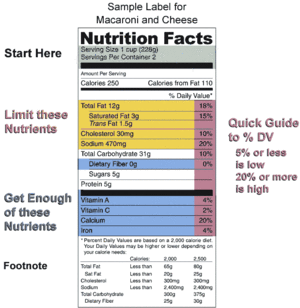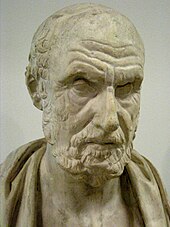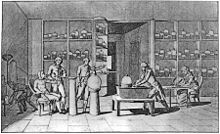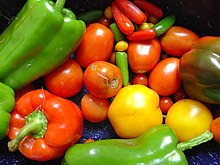Nutrition
From Wikipedia, the free encyclopedia
Nutrition is the science that interprets the interaction of nutrients and other substances in food in relation to maintenance, growth, reproduction, health and disease of an organism. It includes food intake, absorption, assimilation, biosynthesis, catabolism and excretion.[1]
The diet of an organism is what it eats, which is largely determined by the availability, the processing and palatability of foods. A healthy dietincludes preparation of food and storage methods that preserve nutrients from oxidation, heat or leaching, and that reduce risk offoodborne illness.
A poor diet can cause deficiency diseases such as blindness, anemia,scurvy, preterm birth, stillbirth and cretinism;[2] health-threatening conditions like obesity[3][4] and metabolic syndrome;[5] and such common chronic systemic diseases as cardiovascular disease,[6]diabetes,[7][8] and osteoporosis.[9][10][11] A poor diet can cause thewasting of kwashiorkor in acute cases, and the stunting of marasmus in chronic cases of malnutrition.[2]
Contents
[hide]History[edit]
Antiquity[edit]
The first recorded dietary advice, carved into a Babylonian stone tablet in about 2500 BC, cautioned those with pain inside to avoid eating onions for three days. Scurvy, later found to be a vitamin C deficiency, was first described in 1500 BC in the Ebers Papyrus.[12]
According to Walter Gratzer, the study of nutrition probably began during the 6th century BC. In China, the concept of Qi developed, a spirit or "wind" similar to what Western Europeans later called pneuma.[13] Food was classified into "hot" (for example, meats, blood, ginger, and hot spices) and "cold" (green vegetables) in China, India, Malaya, and Persia.[14]Humours developed perhaps first in China alongside qi.[13] Ho the Physician concluded that diseases are caused by deficiencies of elements (Wu Xing: fire, water, earth, wood, and metal), and he classified diseases as well as prescribed diets.[14] About the same time in Italy, Alcmaeon of Croton (a Greek) wrote of the importance of equilibrium between what goes in and what goes out, and warned that imbalance would result in disease marked byobesity or emaciation.[15]
The first recorded nutritional experiment with human subjects is found in the Bible's Book of Daniel. Daniel and his friends were captured by the king of Babylon during an invasion of Israel. Selected as court servants, they were to share in the king's fine foods and wine. But they objected, preferring vegetables (pulses) and water in accordance with their Jewish dietary restrictions. The king's chief steward reluctantly agreed to a trial. Daniel and his friends received their diet for ten days and were then compared to the king's men. Appearing healthier, they were allowed to continue with their diet.[16][17]
Around 475 BC, Anaxagoras stated that food is absorbed by the human body and, therefore, contains "homeomerics" (generative components), suggesting the existence of nutrients.[18] Around 400 BC, Hippocrates, who recognized and was concerned with obesity, which may have been common in southern Europe at the time,[15] said, "Let food be your medicine and medicine be your food."[19] The works that are still attributed to him, Corpus Hippocraticum, called for moderation and emphasized exercise.[15]
Salt, pepper and other spices were prescribed for various ailments in various preparations for example mixed with vinegar. In the 2nd century BC, Cato the Elder believed that cabbage(or the urine of cabbage-eaters) could cure digestive diseases, ulcers, warts, and intoxication. Living about the turn of the millennium, Aulus Celsus, an ancient Roman doctor, believed in "strong" and "weak" foods (bread for example was strong, as were older animals and vegetables).[20]
Galen to Lind[edit]
One mustn't overlook the doctrines of Galen: In use from his life in the 1st century AD until the 17th century, it was heresy to disagree with him for 1500 years.[21] Galen was physician to gladiators in Pergamon, and in Rome, physician to Marcus Aurelius and the three emperors who succeeded him.[22] Most of Galen's teachings were gathered and enhanced in the late 11th century by Benedictine monks at the School of Salerno in Regimen sanitatis Salernitanum, which still had users in the 17th century.[23] Galen believed in the bodilyhumours of Hippocrates, and he taught that pneuma is the source of life. Four elements(earth, air, fire and water) combine into "complexion", which combines into states (the four temperaments: sanguine, phlegmatic, choleric, and melancholic). The states are made up of pairs of attributes (hot and moist, cold and moist, hot and dry, and cold and dry), which are made of four humours: blood, phlegm, green (or yellow) bile, and black bile (the bodily form of the elements). Galen thought that for a person to have gout, kidney stones, or arthritis was scandalous, which Gratzer likens to Samuel Butler's Erehwon (1872) where sickness is a crime.[21]
In the 1500s, Paracelsus was probably the first to criticize Galen publicly.[21] Also in the 16th century, scientist and artist Leonardo da Vinci compared metabolism to a burning candle. Leonardo did not publish his works on this subject, but he was not afraid of thinking for himself and he definitely disagreed with Galen.[14] Ultimately, 16th century works of Andreas Vesalius, sometimes called the father of modern medicine, overturned Galen's ideas.[25] He was followed by piercing thought amalgamated with the era's mysticism and religion sometimes fueled by the mechanics of Newton and Galileo. Jan Baptist van Helmont, who discovered several gases such as carbon dioxide, performed the first quantitative experiment. Robert Boyle advanced chemistry. Sanctorius measured body weight. PhysicianHerman Boerhaave modeled the digestive process. Physiologist Albrecht von Haller worked out the difference between nerves and muscles.[26]
Sometimes forgotten during his life, James Lind, a physician in the British navy, performed the first scientific nutrition experiment in 1747. Lind discovered that lime juice saved sailors that had been at sea for years from scurvy, a deadly and painful bleeding disorder. Between 1500 and 1800, an estimated two million sailors had died of scurvy.[27] The discovery was ignored for forty years, after which British sailors became known as "limeys."[28] The essential vitamin C within citrus fruits would not be identified by scientists until 1932.[27]
Lavoisier and modern science[edit]
Around 1770, Antoine Lavoisier discovered the details of metabolism, demonstrating that the oxidation of food is the source of body heat. Called the most fundamental chemical discovery of the 18th century,[30] Lavoisier discovered the principle ofconservation of mass. His ideas made the phlogiston theory of combustionobsolete.[31]
In 1790, George Fordyce recognized calcium as necessary for the survival of fowl. In the early 19th century, the elements carbon, nitrogen, hydrogen, and oxygen were recognized as the primary components of food, and methods to measure their proportions were developed.[32]
In 1816, François Magendie discovered that dogs fed only carbohydrates (sugar),fat (olive oil), and water died evidently of starvation, but dogs also fed protein survived, identifying protein as an essential dietary component.[33] William Prout in 1827 was the first person to divide foods into carbohydrates, fat, and protein.[34] During the 19th century, Jean-Baptiste Dumas and Justus von Liebig quarrelled over their shared belief that animals get their protein directly from plants (animal and plant protein are the same and that humans do not create organic compounds).[35] With a reputation as the leadingorganic chemist of his day but with no credentials in animal physiology,[36] Liebig grew rich making food extracts like beefbouillon and infant formula that were later found to be of questionable nutritious value.[37] In the 1860s, Claude Bernarddiscovered that body fat can be synthesized from carbohydrate and protein, showing that the energy in blood glucose can be stored as fat or as glycogen.[38]
In the early 1880s, Kanehiro Takaki observed that Japanese sailors (whose diets consisted almost entirely of white rice) developed beriberi (or endemic neuritis, a disease causing heart problems and paralysis), but British sailors and Japanese naval officers did not. Adding various types of vegetables and meats to the diets of Japanese sailors prevented the disease, (not because of the increased protein as Takaki supposed but because it introduced a few parts per million of thiamine to the diet, later understood as a cure[39]).
In 1896, Eugen Baumann observed iodine in thyroid glands. In 1897, Christiaan Eijkman worked with natives of Java, who also suffered from beriberi. Eijkman observed that chickens fed the native diet of white rice developed the symptoms of beriberi but remained healthy when fed unprocessed brown rice with the outer bran intact. Eijkman cured the natives by feeding them brown rice, discovering that food can cure disease. Over two decades later, nutritionists learned that the outer rice bran contains vitamin B1, also known as thiamine.
From 1900 to the present[edit]
In the early 20th century, Carl von Voit and Max Rubner independently measured caloric energy expenditure in different species of animals, applying principles of physics in nutrition. In 1906, Edith G. Willcock and Frederick Hopkins showed that the amino acid tryptophan aids the well-being of mice but it did not assure their growth.[40] In the middle of twelve years of attempts to isolate them,[41] Hopkins said in a 1906 lecture that "unsuspected dietetic factors," other than calories, protein, and minerals, are needed to prevent deficiency diseases.[42] In 1907, Stephen M. Babcock and Edwin B. Hart started the cow feeding, single-grain experiment, which took nearly four years to complete.
| Vitamin | Year Isolated[43] |
|---|---|
| Thiamin | 1926 |
| Vitamin C | 1926 |
| Vitamin A | 1939 |
| Vitamin D | 1931 |
| Vitamin E | 1936 |
| Niacin | 1937 |
| Biotin | 1939 |
| Vitamin K | 1939 |
| Pantothenic acid | 1939 |
| Folate | 1939 |
| Riboflavin | 1933 |
| Vitamin B6 | 1936 |
Oxford University closed down its nutrition department after World War II because the subject seemed to have been completed between 1912 and 1944.[44]
In 1912, Casimir Funk coined the term vitamin, a vital factor in the diet, from the words "vital" and "amine," because these unknown substances preventing scurvy, beriberi, and pellagra, were thought then to be derived from ammonia. The vitamins were studied in the first half of the 20th century.
In 1913, Elmer McCollum and Marguerite Davis discovered the first vitamin, fat-soluble vitamin A, then water-soluble vitamin B (in 1915; now known to be a complex of several water-soluble vitamins) and named vitamin C as the then-unknown substance preventing scurvy. Lafayette Mendel and Thomas Osborne also performed pioneering work on vitamins A and B. In 1919, SirEdward Mellanby incorrectly identified rickets as a vitamin A deficiency because he could cure it in dogs with cod liver oil.[45] In 1922, McCollum destroyed the vitamin A in cod liver oil, but found that it still cured rickets.[45]Also in 1922, H.M. Evans and L.S. Bishop discover vitamin E as essential for rat pregnancy, originally calling it "food factor X" until 1925.
In 1925, Hart discovered that trace amounts of copper are necessary for ironabsorption. In 1927, Adolf Otto Reinhold Windaus synthesized vitamin D, and was awarded the Nobel Prize in Chemistry in 1928. In 1928, Albert Szent-Györgyi isolated ascorbic acid, and in 1932 proved that it is vitamin C by preventing scurvy. In 1935, he synthesized it, and in 1937, he won a Nobel Prize for his efforts. Szent-Györgyi concurrently elucidated much of the citric acid cycle.
In the 1930s, William Cumming Rose identified essential amino acids, necessary protein components that the body cannot synthesize. In 1935, Underwood and Marston independently discovered the necessity of cobalt. In 1936, Eugene Floyd DuBois showed that work and school performance are related to caloric intake. In 1938, Erhard Fernholz discovered the chemical structure of vitamin E and then he tragically disappeared.[46][47] It was synthesised the same year by Paul Karrer.[46]
In 1940, rationing in the United Kingdom during and after World War II took place according to nutritional principles drawn up by Elsie Widdowson and others. In 1941, the first Recommended Dietary Allowances (RDAs) were established by theNational Research Council.
In 1992, The U.S. Department of Agriculture introduced the Food Guide Pyramid.[48] This replaced the Four Food Groups(1956-1992) and was superseded by the concept of MyPlate (2011-present).
A 2014 meta-analysis concluded that adenovirus 36 (Ad36) infection is associated with an increased risk of obesity development.[49]
Nutrients[edit]
The list of nutrients that people are known to require is, in the words of Marion Nestle, "almost certainly incomplete".[50] As of 2014, nutrients are thought to be of two types: macro-nutrients which are needed in relatively large amounts, andmicronutrients which are needed in smaller quantities.[51] A type of carbohydrate, dietary fiber, i.e. non-digestible material such as cellulose, is required,[52] for both mechanical and biochemical reasons, although the exact reasons remain unclear. Some nutrients can be stored - the fat-soluble vitamins - while others are required more or less continuously. Poor health can be caused by a lack of required nutrients, or for some vitamins and minerals, too much of a required nutrient.
Macronutrients[edit]
The macronutrients are carbohydrates, fiber, fats, protein, and water.[51] The macronutrients (excluding fiber and water) provide structural material (amino acids from which proteins are built, and lipids from which cell membranes and some signaling molecules are built) and energy. Some of the structural material can be used to generate energy internally, and in either case it is measured in Joules or kilocalories (often called "Calories" and written with a capital C to distinguish them from little 'c' calories). Carbohydrates and proteins provide 17 kJ approximately (4 kcal) of energy per gram, while fats provide 37 kJ (9 kcal) per gram,[53] though the net energy from either depends on such factors as absorption and digestive effort, which vary substantially from instance to instance. Vitamins, minerals, fiber, and water do not provide energy, but are required for other reasons.
Molecules of carbohydrates and fats consist of carbon, hydrogen, and oxygen atoms. Carbohydrates range from simplemonosaccharides (glucose, fructose, galactose) to complex polysaccharides (starch). Fats are triglycerides, made of assorted fatty acid monomers bound to a glycerol backbone. Some fatty acids, but not all, are essential in the diet: they cannot be synthesized in the body. Protein molecules contain nitrogen atoms in addition to carbon, oxygen, and hydrogen. The fundamental components of protein are nitrogen-containing amino acids, some of which are essential in the sense that humans cannot make them internally. Some of the amino acids are convertible (with the expenditure of energy) to glucose and can be used for energy production, just as ordinary glucose, in a process known as gluconeogenesis. By breaking down existing protein, the carbon skeleton of the various amino acids can be metabolized to intermediates in cellular respiration; the remaining ammonia is discarded primarily as urea in urine.
Carbohydrates[edit]
Carbohydrates may be classified as monosaccharides, disaccharides, or polysaccharides depending on the number of monomer (sugar) units they contain. They constitute a large part of foods such as rice, noodles, bread, and other grain-based products, also potatoes, yams, beans, fruits, fruit juices and vegetables. Monosaccharides, disaccharides, and polysaccharides contain one, two, and three or more sugar units, respectively. Polysaccharides are often referred to ascomplex carbohydrates because they are typically long, multiple branched chains of sugar units.
Traditionally, simple carbohydrates are believed to be absorbed quickly, and therefore to raise blood-glucose levels more rapidly than complex carbohydrates. This, however, is not accurate.[54][55][56][57] Some simple carbohydrates (e.g., fructose) follow different metabolic pathways (e.g., fructolysis) that result in only a partial catabolism to glucose, while, in essence, many complex carbohydrates may be digested at the same rate as simple carbohydrates.[58] The World Health Organization (WHO) recommends that added sugars should represent no more than 10% of total energy intake.[59]
Fiber[edit]
Dietary fiber is a carbohydrate that is incompletely absorbed in humans and in some animals. Like all carbohydrates, when it is metabolized it can produce four Calories (kilocalories) of energy per gram. However, in most circumstances it accounts for less than that because of its limited absorption and digestibility. Dietary fiber consists mainly of cellulose, a large carbohydrate polymer which is indigestible as humans do not have the required enzymes to disassemble it. There are two subcategories: soluble and insoluble fiber. Whole grains, fruits (especially plums, prunes, and figs), and vegetables are good sources of dietary fiber. There are many health benefits of a high-fiber diet. Dietary fiber helps reduce the chance of gastrointestinal problems such as constipation and diarrhea by increasing the weight and size of stool and softening it. Insoluble fiber, found in whole wheat flour, nuts and vegetables, especially stimulates peristalsis – the rhythmic muscular contractions of the intestines, which move digesta along the digestive tract. Soluble fiber, found in oats, peas, beans, and many fruits, dissolves in water in the intestinal tract to produce a gel that slows the movement of food through the intestines. This may help lower blood glucose levels because it can slow the absorption of sugar. Additionally, fiber, perhaps especially that from whole grains, is thought to possibly help lessen insulin spikes, and therefore reduce the risk of type 2 diabetes. The link between increased fiber consumption and a decreased risk of colorectal cancer is still uncertain.
Fat[edit]
A molecule of dietary fat typically consists of several fatty acids (containing long chains of carbon and hydrogen atoms), bonded to a glycerol. They are typically found as triglycerides (three fatty acids attached to one glycerol backbone). Fats may be classified as saturated or unsaturated depending on the detailed structure of the fatty acids involved. Saturated fats have all of the carbon atoms in their fatty acid chains bonded to hydrogen atoms, whereas unsaturated fats have some of these carbon atoms double-bonded, so their molecules have relatively fewer hydrogen atoms than a saturated fatty acid of the same length. Unsaturated fats may be further classified as monounsaturated (one double-bond) or polyunsaturated (many double-bonds). Furthermore, depending on the location of the double-bond in the fatty acid chain, unsaturated fatty acids are classified as omega-3 or omega-6 fatty acids. Trans fats are a type of unsaturated fat with trans-isomer bonds; these are rare in nature and in foods from natural sources; they are typically created in an industrial process called (partial)hydrogenation. There are nine kilocalories in each gram of fat. Fatty acids such as conjugated linoleic acid, catalpic acid, eleostearic acid and punicic acid, in addition to providing energy, represent potent immune modulatory molecules.
Saturated fats (typically from animal sources) have been a staple in many world cultures for millennia. Unsaturated fats (e. g., vegetable oil) are considered healthier, while trans fats are to be avoided. Saturated and some trans fats are typically solid at room temperature (such as butter or lard), while unsaturated fats are typically liquids (such as olive oil or flaxseed oil). Trans fats are very rare in nature, and have been shown to be highly detrimental to human health, but have properties useful in the food processing industry, such as rancidity resistance.[60]
Essential fatty acids[edit]
Most fatty acids are non-essential, meaning the body can produce them as needed, generally from other fatty acids and always by expending energy to do so. However, in humans, at least two fatty acids are essential and must be included in the diet. An appropriate balance of essential fatty acids—omega-3 and omega-6 fatty acids—seems also important for health, although definitive experimental demonstration has been elusive. Both of these "omega" long-chain polyunsaturated fatty acids are substrates for a class of eicosanoids known as prostaglandins, which have roles throughout the human body. They are hormones, in some respects. The omega-3 eicosapentaenoic acid (EPA), which can be made in the human body from the omega-3 essential fatty acid alpha-linolenic acid (ALA), or taken in through marine food sources, serves as a building block for series 3 prostaglandins (e.g., weakly inflammatory PGE3). The omega-6 dihomo-gamma-linolenic acid (DGLA) serves as a building block for series 1 prostaglandins (e.g. anti-inflammatory PGE1), whereas arachidonic acid (AA) serves as a building block for series 2 prostaglandins (e.g. pro-inflammatory PGE 2). Both DGLA and AA can be made from the omega-6 linoleic acid (LA) in the human body, or can be taken in directly through food. An appropriately balanced intake of omega-3 and omega-6 partly determines the relative production of different prostaglandins, which is one reason why a balance between omega-3 and omega-6 is believed important for cardiovascular health. In industrialized societies, people typically consume large amounts of processed vegetable oils, which have reduced amounts of the essential fatty acids along with too much of omega-6 fatty acids relative to omega-3 fatty acids.
The conversion rate of omega-6 DGLA to AA largely determines the production of the prostaglandins PGE1 and PGE2. Omega-3 EPA prevents AA from being released from membranes, thereby skewing prostaglandin balance away from pro-inflammatory PGE2 (made from AA) toward anti-inflammatory PGE1 (made from DGLA). Moreover, the conversion (desaturation) of DGLA to AA is controlled by the enzyme delta-5-desaturase, which in turn is controlled by hormones such as insulin (up-regulation) and glucagon (down-regulation). The amount and type of carbohydrates consumed, along with some types of amino acid, can influence processes involving insulin, glucagon, and other hormones; therefore, the ratio of omega-3 versus omega-6 has wide effects on general health, and specific effects on immune function and inflammation, andmitosis (i.e., cell division).
Protein[edit]
Proteins are structural materials in much of the animal body (e.g. muscles, skin, and hair). They also form the enzymes that control chemical reactions throughout the body. Each protein molecule is composed of amino acids, which are characterized by inclusion of nitrogen and sometimes sulphur (these components are responsible for the distinctive smell of burning protein, such as the keratin in hair). The body requires amino acids to produce new proteins (protein retention) and to replace damaged proteins (maintenance). As there is no protein or amino acid storage provision, amino acids must be present in the diet. Excess amino acids are discarded, typically in the urine. For all animals, some amino acids are essential (an animal cannot produce them internally) and some are non-essential (the animal can produce them from other nitrogen-containing compounds). About twenty amino acids are found in the human body, and about ten of these are essential and, therefore, must be included in the diet. A diet that contains adequate amounts of amino acids (especially those that are essential) is particularly important in some situations: during early development and maturation, pregnancy, lactation, or injury (a burn, for instance). A complete protein source contains all the essential amino acids; anincomplete protein source lacks one or more of the essential amino acids.
It is possible with protein combinations of two incomplete protein sources (e.g., rice and beans) to make a complete protein source, and characteristic combinations are the basis of distinct cultural cooking traditions. However, complementary sources of protein do not need to be eaten at the same meal to be used together by the body.[61] Excess amino acids from protein can be converted into glucose and used for fuel through a process called gluconeogenesis.
Water[edit]
Water is excreted from the body in multiple forms; including urine and feces,sweating, and by water vapour in the exhaled breath. Therefore, it is necessary to adequately rehydrate to replace lost fluids.
Early recommendations for the quantity of water required for maintenance of good health suggested that 6–8 glasses of water daily is the minimum to maintain properhydration.[62] However the notion that a person should consume eight glasses of water per day cannot be traced to a credible scientific source.[63] The original water intake recommendation in 1945 by the Food and Nutrition Board of the National Research Council read: "An ordinary standard for diverse persons is 1 milliliter for each calorie of food. Most of this quantity is contained in prepared foods."[64] More recent comparisons of well-known recommendations on fluid intake have revealed large discrepancies in the volumes of water we need to consume for good health.[65] Therefore, to help standardize guidelines, recommendations for water consumption are included in two recent European Food Safety Authority (EFSA) documents (2010): (i) Food-based dietary guidelines and (ii) Dietary reference values for water or adequate daily intakes (ADI).[66] These specifications were provided by calculating adequate intakes from measured intakes in populations of individuals with “desirable osmolarity values of urine and desirable water volumes per energy unit consumed.”[66]
For healthful hydration, the current EFSA guidelines recommend total water intakes of 2.0 L/day for adult females and 2.5 L/day for adult males. These reference values include water from drinking water, other beverages, and from food. About 80% of our daily water requirement comes from the beverages we drink, with the remaining 20% coming from food.[67] Water content varies depending on the type of food consumed, with fruit and vegetables containing more than cereals, for example.[68] These values are estimated using country-specific food balance sheets published by the Food and Agriculture Organisation of the United Nations.[68]
The EFSA panel also determined intakes for different populations. Recommended intake volumes in the elderly are the same as for adults as despite lower energy consumption, the water requirement of this group is increased due to a reduction in renal concentrating capacity.[66] Pregnant and breastfeeding women require additional fluids to stay hydrated. The EFSA panel proposes that pregnant women should consume the same volume of water as non-pregnant women, plus an increase in proportion to the higher energy requirement, equal to 300 mL/day.[66] To compensate for additional fluid output, breastfeeding women require an additional 700 mL/day above the recommended intake values for non-lactating women. Dehydration and over-hydration - too little and too much water, respectively - can have harmful consequences.[66][69]
Micronutrients[edit]
Minerals[edit]
Dietary minerals are inorganic chemical elements required by living organisms,[70] other than the four elements carbon,hydrogen, nitrogen, and oxygen that are present in nearly all organic molecules. The term "mineral" is archaic, since the intent is to describe simply the less common elements in the diet. Some are heavier than the four just mentioned, including several metals, which often occur as ions in the body. Some dietitians recommend that these be supplied from foods in which they occur naturally, or at least as complex compounds, or sometimes even from natural inorganic sources (such as calcium carbonate from ground oyster shells). Some minerals are absorbed much more readily in the ionic forms found in such sources. On the other hand, minerals are often artificially added to the diet as supplements; the most famous is likely iodine in iodized salt which prevents goiter.
Macrominerals[edit]
Many elements are essential in relative quantity; they are usually called "bulk minerals". Some are structural, but many play a role as electrolytes.[71] Elements with recommended dietary allowance (RDA) greater than 150 mg/day are, in alphabetical order (with informal or folk-medicine perspectives in parentheses):
- Calcium, a common electrolyte, but also needed structurally (for muscle and digestive system health, bone strength, some forms neutralize acidity, may help clear toxins, provides signaling ions for nerve and membrane functions)
- Chlorine as chloride ions; very common electrolyte; see sodium, below
- Magnesium, required for processing ATP and related reactions (builds bone, causes strong peristalsis, increases flexibility, increases alkalinity)
- Phosphorus, required component of bones; essential for energy processing[72]
- Potassium, a very common electrolyte (heart and nerve health)
- Sodium, a very common electrolyte; in general not found in dietary supplements, despite being needed in large quantities, because the ion is very common in food: typically as sodium chloride, or common salt. Excessive sodium consumption can deplete calcium and magnesium,[verification needed] leading to high blood pressure and osteoporosis.
- Sulfur, for three essential amino acids and therefore many proteins (skin, hair, nails, liver, and pancreas). Sulfur is not consumed alone, but in the form of sulfur-containing amino acids
Trace minerals[edit]
Many elements are required in trace amounts, usually because they play a catalytic role in enzymes.[73] Some trace mineral elements (RDA < 200 mg/day) are, in alphabetical order:
- Cobalt required for biosynthesis of vitamin B12 family of coenzymes. Animals cannot biosynthesize B12, and must obtain this cobalt-containing vitamin in their diet.
- Copper required component of many redox enzymes, including cytochrome c oxidase
- Chromium required for sugar metabolism
- Iodine required not only for the biosynthesis of thyroxine but also — it is presumed — for other important organs as breast, stomach, salivary glands, thymus, etc. (see Extrathyroidal iodine); for this reason iodine is needed in larger quantities than others in this list, and sometimes classified with the macrominerals
- Iron required for many enzymes, and for hemoglobin and some other proteins
- Manganese (processing of oxygen)
- Molybdenum required for xanthine oxidase and related oxidases
- Selenium required for peroxidase (antioxidant proteins)
- Zinc required for several enzymes such as carboxypeptidase, liver alcohol dehydrogenase, and carbonic anhydrase
Vitamins[edit]
Vitamins are essential nutrients,[70] necessary in the diet for good health. (Vitamin D is the exception, as it can be synthesized in the skin in the presence of UVB radiation.) Vitamin deficiencies may result in disease conditions, includinggoitre, scurvy, osteoporosis, impaired immune system, disorders of cell metabolism, certain forms of cancer, symptoms of premature aging, and poor psychological health, among many others.[74] Excess levels of some vitamins are also dangerous to health. The Food and Nutrition Board of the Institute of Medicine has established Tolerable Upper Intake Levels (ULs) for seven vitamins. [75]
Healthy diets[edit]
Whole plant food diet[edit]
Heart disease, cancer, obesity, and diabetes are commonly called "Western" diseases because these maladies were once rarely seen in developing countries. An international study in China found some regions had virtually no cancer or heart disease, while in other areas they reflected "up to a 100-fold increase" coincident with shifts from diets that were found to be entirely plant-based to heavily animal-based, respectively.[76] In contrast, diseases of affluence like cancer and heart disease are common throughout the developed world, including the United States. Adjusted for age and exercise, large regional clusters of people in China rarely suffered from these "Western" diseases possibly because their diets are rich in vegetables, fruits, and whole grains, and have little dairy and meat products.[76]There are arguments for and against this controversial issue.
The French "paradox"[edit]
The French paradox was an observation from the 1980s that the French suffer a relatively low incidence of coronary heart disease, despite having a diet relatively rich in saturated fats. A number of explanations were suggested:
- Saturated fat consumption does not cause heart disease.[77]
- Compared to U.S., less consumption of processed carbohydrate and other junk foods, and more consumption of fruits, vegetables, whole grains and fish.[78]
- Regular consumption of red wine.[79]
- Compared to U.S., lower consumption of artificially produced trans-fats, which has been shown to have greater cholesterol raising effects than saturated fat.[80]
However, statistics collected by the World Health Organization from 1990–2000 show that the incidence of heart disease in France may have been underestimated and, in fact, may be similar to that of neighboring countries.[81]
Phytochemicals[edit]
Phytochemicals such as polyphenols are compounds produced naturally in plants (phyto means "plant" in Greek). In general, the term is used to refer to those chemicals under research to assess whether they have biological significance. To date, there is no evidence in humans that polyphenols or other non-nutrient compounds from plants have health effects.[82][83]
While initial studies sought to reveal if nutrient antioxidant supplements might promote health, one meta-analysis concluded that supplementation with vitamins A and E and beta-carotene did not convey any benefits and may in fact increase risk of death. Vitamin C and selenium supplements did not impact mortality rate. Health effects of non-nutrient phytochemicals such as polyphenols were not assessed.[84][85]
Intestinal bacterial flora[edit]
Animal intestines contain a large population of gut flora. In humans, the four dominant phyla are Firmicutes, Bacteroidetes, Actinobacteria, and Proteobacteria.[86]They are essential to digestion and are also affected by food that is consumed. Bacteria in the large intestine perform many important functions for humans, including breaking down and aiding in the absorption of soluble fiber, stimulating cell growth, repressing the growth of harmful bacteria, training the immune system to respond only to pathogens, producing vitamin B12, and defending against some infectious diseases.[87] "Probiotics" refers to the idea of deliberately consuming live bacteria in an attempt to change the bacterial population in the large intestine, to the health benefit of the host human or animal. "Prebiotic (nutrition)" refers to the idea that consuming a bacterial energy source such as soluble fiber could support the population of health-beneficial bacteria in the large intestine. There is not yet a scientific consensus as to health benefits accruing from probiotics or prebiotics.
Animal nutrition[edit]
Carnivore and herbivore diets are contrasting, with basic nitrogen and carbon proportions vary for their particular foods. Many herbivores rely on bacterial fermentation to create digestible nutrients from indigestible plant cellulose, while obligate carnivores must eat animal meats to obtain certain vitamins or nutrients their bodies cannot otherwise synthesize.[88]
Plant nutrition[edit]
Plant nutrition is the study of the chemical elements that are necessary for plant growth.[89] There are several principles that apply to plant nutrition. Some elements are directly involved in plant metabolism. However, this principle does not account for the so-called beneficial elements, whose presence, while not required, has clear positive effects on plant growth.
A nutrient that is able to limit plant growth according to Liebig's law of the minimum is considered an essential plant nutrient if the plant cannot complete its full life cycle without it. There are 16 essential plant soil nutrients, besides the three major elemental nutrients carbon and oxygen that are obtained by photosynthetic plants from carbon dioxide in air, and hydrogen, which is obtained from water.
Plants uptake essential elements from the soil through their roots and from the air (consisting of mainly nitrogen and oxygen) through their leaves. Green plants obtain their carbohydrate supply from the carbon dioxide in the air by the process of photosynthesis. Carbon and oxygen are absorbed from the air, while other nutrients are absorbed from the soil. Nutrient uptake in the soil is achieved by cation exchange, wherein root hairs pump hydrogen ions (H+) into the soil throughproton pumps. These hydrogen ions displace cations attached to negatively charged soil particles so that the cations are available for uptake by the root. In the leaves, stomata open to take in carbon dioxide and expel oxygen. The carbon dioxide molecules are used as the carbon source in photosynthesis.
Although nitrogen is plentiful in the Earth's atmosphere, very few plants can use this directly. Most plants, therefore, require nitrogen compounds to be present in the soil in which they grow. This is made possible by the fact that largely inert atmospheric nitrogen is changed in a nitrogen fixation process to biologically usable forms in the soil by bacteria.[90]
Plant nutrition is a difficult subject to understand completely, partially because of the variation between different plants and even between different species or individuals of a given clone. Elements present at low levels may cause deficiency symptoms, and toxicity is possible at levels that are too high. Furthermore, deficiency of one element may present as symptoms of toxicity from another element, and vice versa.
Environmental nutrition[edit]
Research in the field of nutrition has greatly contributed in finding out the essential facts about how environmental depletion can lead to crucial nutrition-related health problems like contamination, spread of contagious diseases, malnutrition, etc. Moreover, environmental contamination due to discharge of agricultural as well as industrial chemicals like organocholrines, heavy metal, and radionucleotides may adversely affect the human and the ecosystem as a whole. As far as safety of the human health is concerned, then these environmental contaminants can reduce people's nutritional status and health. This could directly or indirectly cause drastic changes in their diet habits. Hence, food-based remedial as well as preventive strategies are essential to address global issues like hunger and malnutrition and to enable the susceptible people to adapt themselves to all these environmental as well as socio-economic alterations.[91]
Advice and guidance[edit]
Government policies[edit]
Canada's Food Guide is another example government-run nutrition program. Produced by Health Canada, the guide advises food quantities, provides education on balanced nutrition, and promotes physical activity in accordance with government-mandated nutrient needs. Like other nutrition programs around the world, Canada's Food Guide divides nutrition into four main food groups: vegetables and fruit, grain products, milk and alternatives, and meat and alternatives.[92] It is interesting to note that, unlike its American counterpart, the Canadian guide references and provides alternative to meat and dairy, which can be attributed to the growing vegan and vegetarian movements.
In the US, nutritional standards and recommendations are established jointly by the US Department of Agriculture and US Department of Health and Human Services. Dietary and physical activity guidelines from the USDA are presented in the concept of MyPlate, which superseded the food pyramid, which replaced the Four Food Groups. The Senate committee currently responsible for oversight of the USDA is the Agriculture, Nutrition and Forestry Committee. Committee hearings are often televised on C-SPAN. The U.S. Department of Health and Human Services provides a sample week-long menu that fulfills the nutritional recommendations of the government.[93]
Government programs[edit]
Governmental organisations have been working on nutrition literacy interventions in non-primary health care settings to address the nutrition information problem in the U.S. Some programs include:
The Family Nutrition Program (FNP) is a free nutrition education program serving low-income adults around the U.S. This program is funded by the Food Nutrition Service’s (FNS) branch of the United States Department of Agriculture (USDA) usually through a local state academic institution that runs the program. The FNP has developed a series of tools to help families participating in the Food Stamp Program stretch their food dollar and form healthful eating habits including nutrition education.
Expanded Food and Nutrition Education Program (ENFEP) is a unique program that currently operates in all 50 states and in American Samoa, Guam, Micronesia, Northern Marianas, Puerto Rico, and the Virgin Islands. It is designed to assist limited-resource audiences in acquiring the knowledge, skills, attitudes, and changed behavior necessary for nutritionally sound diets, and to contribute to their personal development and the improvement of the total family diet and nutritional well-being.
An example of a state initiative to promote nutrition literacy is Smart Bodies, a public-private partnership between the state’s largest university system and largest health insurer, Louisiana State Agricultural Center and Blue Cross and Blue Shield of Louisiana Foundation. Launched in 2005, this program promotes lifelong healthful eating patterns and physically active lifestyles for children and their families. It is an interactive educational program designed to help prevent childhood obesity through classroom activities that teach children healthful eating habits and physical exercise.
Education[edit]
Nutrition is taught in schools in many countries. In England and Wales, the Personal and Social Education and Food Technology curricula include nutrition, stressing the importance of a balanced diet and teaching how to read nutrition labels on packaging. In many schools, a Nutrition class will fall within the Family and Consumer Science or Health departments. In some American schools, students are required to take a certain number of FCS or Health related classes. Nutrition is offered at many schools, and, if it is not a class of its own, nutrition is included in other FCS or Health classes such as: Life Skills, Independent Living, Single Survival, Freshmen Connection, Health etc. In many Nutrition classes, students learn about the food groups, the food pyramid, Daily Recommended Allowances, calories, vitamins, minerals, malnutrition, physical activity, healthful food choices, portion sizes, and how to live a healthy life.
A 1985, US National Research Council report entitled Nutrition Education in US Medical Schools concluded that nutrition education in medical schools was inadequate.[94] Only 20% of the schools surveyed taught nutrition as a separate, required course. A 2006 survey found that this number had risen to 30%.[95] Membership by physicians in leading professional nutrition societies such as the American Society for Nutrition has generally declined from the 1990s.[96]
Professional organizations[edit]
In the US, Registered dietitian nutritionists (RDs or RDNs)[97] are health professionals qualified to provide safe, evidence-based dietary advice which includes a review of what is eaten, a thorough review of nutritional health, and a personalized nutritional treatment plan. They also provide preventive and therapeutic programs at work places, schools and similar institutions. Certified Clinical Nutritionists or CCNs, are trained health professionals who also offer dietary advice on the role of nutrition in chronic disease, including possible prevention or remediation by addressing nutritional deficiencies before resorting to drugs.[98] Government regulation especially in terms of licensing, is currently less universal for the CCN than that of RD or RDN. Another advanced Nutrition Professional is a Certified Nutrition Specialist or CNS. These Board Certified Nutritionists typically specialize in obesity and chronic disease. In order to become board certified, potential CNS candidate must pass an examination, much like Registered Dieticians. This exam covers specific domains within the health sphere including; Clinical Intervention and Human Health.[99]
Nutrition literacy[edit]
At the time of this entry, we were not able to identify any specific nutrition literacy studies in the U.S. at a national level. However, the findings of the 2003 National Assessment of Adult Literacy (NAAL) provide a basis upon which to frame the nutrition literacy problem in the U.S. NAAL introduced the first ever measure of "the degree to which individuals have the capacity to obtain, process and understand basic health information and services needed to make appropriate health decisions" – an objective of Healthy People 2010[100] and of which nutrition literacy might be considered an important subset. On a scale of below basic, basic, intermediate and proficient, NAAL found 13 percent of adult Americans have proficient health literacy, 44% have intermediate literacy, 29 percent have basic literacy and 14 percent have below basic health literacy. The study found that health literacy increases with education and people living below the level of poverty have lower health literacy than those above it.
Another study examining the health and nutrition literacy status of residents of the lower Mississippi Delta found that 52 percent of participants had a high likelihood of limited literacy skills.[101] While a precise comparison between the NAAL and Delta studies is difficult, primarily because of methodological differences, Zoellner et al. suggest that health literacy rates in the Mississippi Delta region are different from the U.S. general population and that they help establish the scope of the problem of health literacy among adults in the Delta region. For example, only 12 percent of study participants identified the My Pyramid graphic two years after it had been launched by the USDA. The study also found significant relationships between nutrition literacy and income level and nutrition literacy and educational attainment[101] further delineating priorities for the region.
These statistics point to the complexities surrounding the lack of health/nutrition literacy and reveal the degree to which they are embedded in the social structure and interconnected with other problems. Among these problems are the lack of information about food choices, a lack of understanding of nutritional information and its application to individual circumstances, limited or difficult access to healthful foods, and a range of cultural influences and socioeconomic constraints such as low levels of education and high levels of poverty that decrease opportunities for healthful eating and living.
The links between low health literacy and poor health outcomes has been widely documented[102] and there is evidence that some interventions to improve health literacy have produced successful results in the primary care setting. More must be done to further our understanding of nutrition literacy specific interventions in non-primary care settings[101] in order to achieve better health outcomes.
Malnutrition[edit]
Malnutrition refers to insufficient, excessive, or imbalanced consumption of nutrients by an organism. In developed countries, the diseases of malnutrition are most often associated with nutritional imbalances or excessive consumption. In developing countries, malnutrition is more likely to be caused by poor access to a range of nutritious foods or inadequate knowledge. InMali the International Crops Research Institute for the Semi-Arid Tropics (ICRISAT) and the Aga Khan Foundation, trained women's groups to make equinut, a healthy and nutritional version of the traditional recipe di-dèguè (comprising peanut paste, honey and millet or rice flour). The aim was to boost nutrition and livelihoods by producing a product that women could make and sell, and which would be accepted by the local community because of its local heritage.[103]
Although there are more organisms in the world who are malnourished due to insufficient consumption, increasingly more organisms suffer from excessive over-nutrition; a problem caused by an over abundance of sustenance coupled with the instinctual desire (by animals in particular) to consume all that it can.
Nutritionism is the view that excessive reliance on food science and the study of nutrition can lead to poor nutrition and to ill health. It was originally credited to Gyorgy Scrinis,[104] and was popularized by Michael Pollan. Since nutrients are invisible, policy makers rely on nutrition experts to advise on food choices. Because science has an incomplete understanding of how food affects the human body, Pollan argues, nutritionism can be blamed for many of the health problems relating to diet in the Western World today.[105][106]
Insufficient[edit]
The U.S. Food and Nutrition Board sets Estimated Average Requirements (EARs) and Recommended Dietary Allowances (RDAs) for vitamins and minerals. EARs and RDAs are part of Dietary Reference Intakes.[107] The DRI documents describe nutrient deficiency signs and symptoms.
Excessive[edit]
The U.S. Food and Nutrition Board sets Tolerable Upper Intake Levels (known as ULs) for vitamins and minerals when evidence is sufficient. ULs are set a safe fraction below amounts shown to cause health problems. ULs are part of Dietary Reference Intakes.[108] The European Food Safety Authority also reviews the same safety questions and set its own ULs.[109]
Unbalanced[edit]
When too much of one or more nutrients is present in the diet to the exclusion of the proper amount of other nutrients, the diet is said to be unbalanced.











very good i like it
ReplyDelete